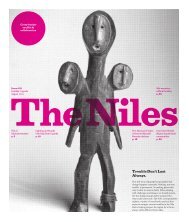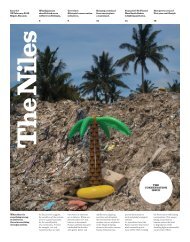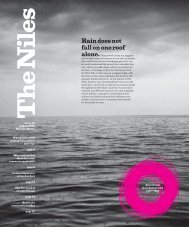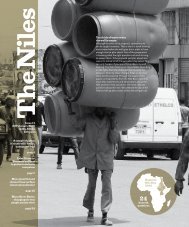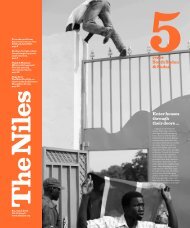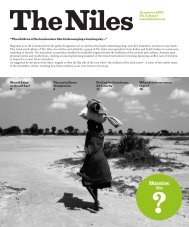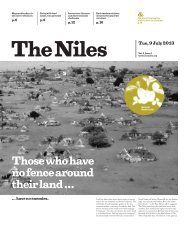We are what we eat
The food we eat literally determines who we are. It influences our physical, mental and even emotional well-being. From Egypt’s Cairo to Burundi’s Gitega, this issue of The Niles attempts to explore the essentials of food: from conflict and food insecurity to the sensory aspects of preparing and eating national dishes.
The food we eat literally determines who we are. It influences our physical, mental and even emotional well-being. From Egypt’s Cairo to Burundi’s Gitega, this issue of The Niles attempts to explore the essentials of food: from conflict and food insecurity to the sensory aspects of preparing and eating national dishes.
You also want an ePaper? Increase the reach of your titles
YUMPU automatically turns print PDFs into web optimized ePapers that Google loves.
“I love coffee, but
I have never tasted
the coffee from
my garden, only
Nescafé that I buy
at an exorbitant
price.”
Reap what you sow!
A poor coffee farmer toils away at the coffee
beans in his garden, but he has never tasted
his own coffee. Instead, he spends his money
on expensive Nescafé.
Davis Mugume
Kampala, Uganda
On a sunny afternoon, George Muhanuka
Tindyebwa grabs a bucket
to pick some coffee cherries from
his garden.
Red-ripened cherries create
beautiful scenery in the four-acre space where
Tindyebwa has planted his coffee. It took him
three years before he could pick any cherries from
this garden, but he was patient.
“I had hoped that I would one day start to benefit
from my garden,” he says.
He diligently pulled weeds, pruned and mulched
his garden. At times he says, he felt desperate
whenever he was hungry and could not find food.
“It’s disturbing to see healthy gardens when
you actually can’t pick a leaf or anything from it,
year after year,” the former teacher says.
Out of frustration, Tindyebwa birthed an
idea. He also started a plantation alongside the
coffee trees.
“I could also interplant some beans in the
coffee garden to survive on as I waited for my coffee
beans to mature.”
Now, Tindyebwa harvests at least 20 bags of
cherries that he dries and takes to a nearby trading
centre for “cleaning”. The cleaning process involves
hurling coffee beans to remove bad coffee beans
and coffee husks.
Out of these, he says he can make at least UGX
1,850,000 (about USD 500) per season. It is still
a work in progress. He is currently harvesting half
the garden.
“I love coffee, but I have never tasted the coffee
from my garden, only Nescafé that I buy at an
exorbitant price,” he says. He sells a kilogram
of coffee at UGX 6,000 (about USD 1.60), but
he buys a small container (50 grams) of Nescafé
at UGX 15,000 (about USD 4).
Unlike other farmers who can live off their crops
at various stages, Tindyebwa has first to sell coffee
to enjoy the fruits of his labour.
“This is so discouraging,” he says.
Rugaya Richard, a coffee entrepreneur and
the owner of Gorilla Highland Coffee, says: “Farmers’
mentalities have to change from the days of
colonisation. They were told that coffee was not
for consumption but rather for making medicines
and bullets.”
Under his label in Kisoro District, Richard
teaches farmers how to roast and package coffee,
not to mention how to process and drink it.
“Famers must be informed that coffee is not
bad and is something they can directly consume,”
he says.
Don’t throw away
the date’s byproducts
The fruit of a date tree is just the beginning
of its usefulness. There are several other uses
for the wood, seeds and leaves.
Rehab Abd Almohsen
Cairo, Egypt
During a session on date palm tree
waste, one audience member raised
his hand to express his objection:
“It should not be called waste, it is
a secondary product. Date palm trees
have zero waste.”
His point received a great deal of support
at the Festival of Egyptian Dates, which has taken
place every year since 2015 in Siwa Oasis in Egypt.
The date tree is known in the Middle East and
North Africa (MENA) region as the ‘Tree of Life’
and has a high level of respect as one of the oldest
trees known and cultivated by man. The tree also
holds a prominent position in Judaism, Christianity
and Islam.
The MENA region produces 90 percent of
all dates globally and includes the ten biggest date
producing countries, topped by Egypt, as the largest
producer of dates, yielding 1.5 million tonnes of
dates annually, according to Food and Agriculture
Organization.
“Imagine that 20 percent of the size of the
tree and its dates go as waste, while each piece
can be turned into a product,” said Khalid Ghanem,
professor of organic agriculture at Al-Azhar University
in Egypt.
“Every part of this tree has a number of uses:
the trunk’s main use is for wood, as light footbridges
or in roof making. Leaves are used to make a wide
variety of containers and crates, baskets and sacks,
and smaller articles like fans and hats.”
There are several attempts to find new outlets
for the annual crop of leaves and empty bunches that
are obligatory by-products of date production. One
of them, according to Ghanem, is animal feed that
has been proven by research to increase cow milk
and soil organic fertiliser.
Another way, he said, is using cull or lowquality
dates, grinding them and making date
paste, which can be applied as a natural sweetener
and an alternative to sugar in baking and cooking
to raise the nutritional value of the product. Date
seeds can also be roasted to make coffee.
Mohamad Kamal, a researcher at the agricultural
research centre, pointed out that one of the benefits
of using dates is its high fibre content and other
nutritional values. “It is rich in protein and fatty
acids and amino acids. It also contains a significant
amount of iron and calcium.”
Kamal believes that the government should
consider importing and researching the technologies
that help improve the use of the by-products.
“Egypt produces a little over 17 percent of global
date production but only contributes to 3 percent
of world exports. With better use of the tree’s
byproducts, exports would go up.”
The country has increased date cultivation by
more than 100 percent since 1993 and announced
a plan to grow the biggest date plantation that would
include around 2,500 million trees to produce
top-quality dates.
13
TN14_20191203_II.indd 13 2019/12/03 10:08




